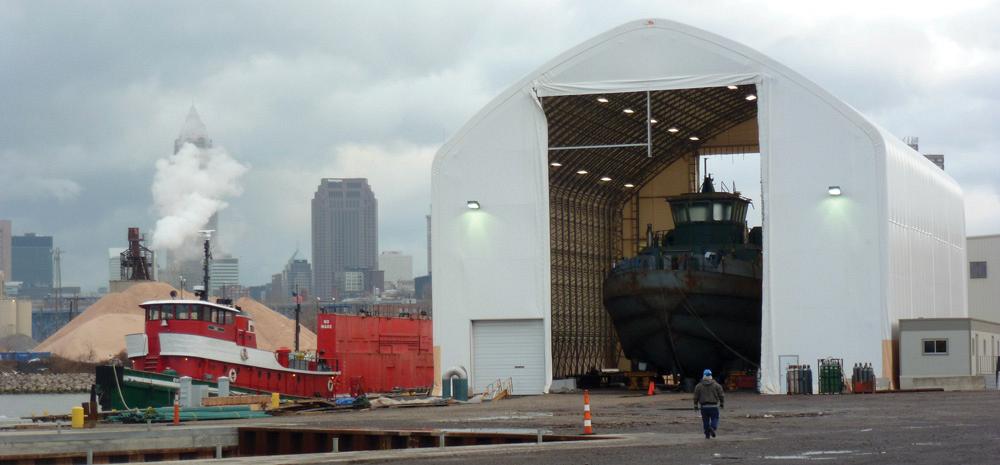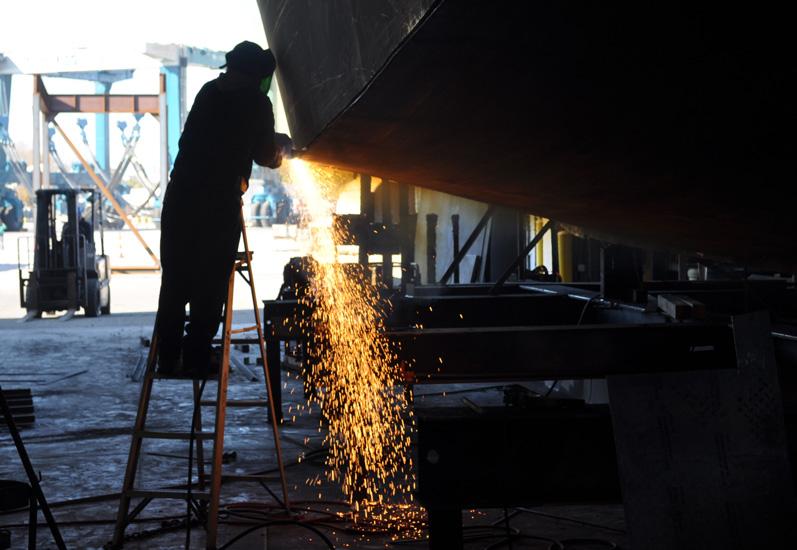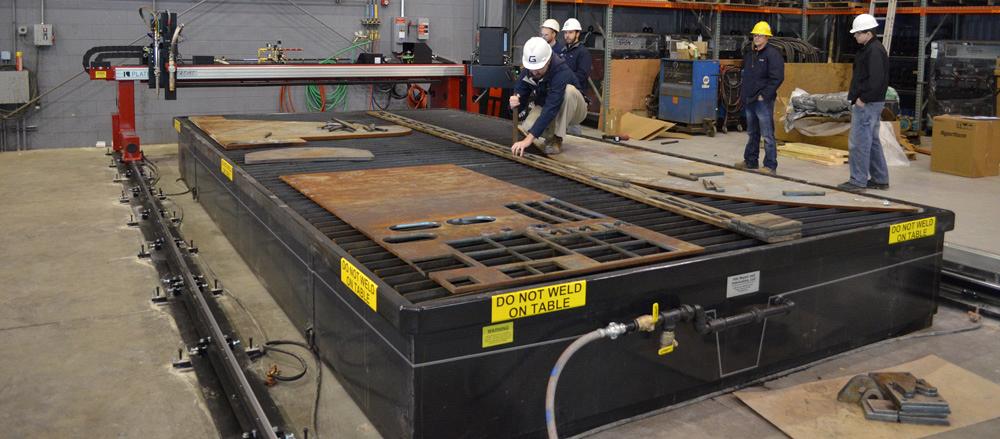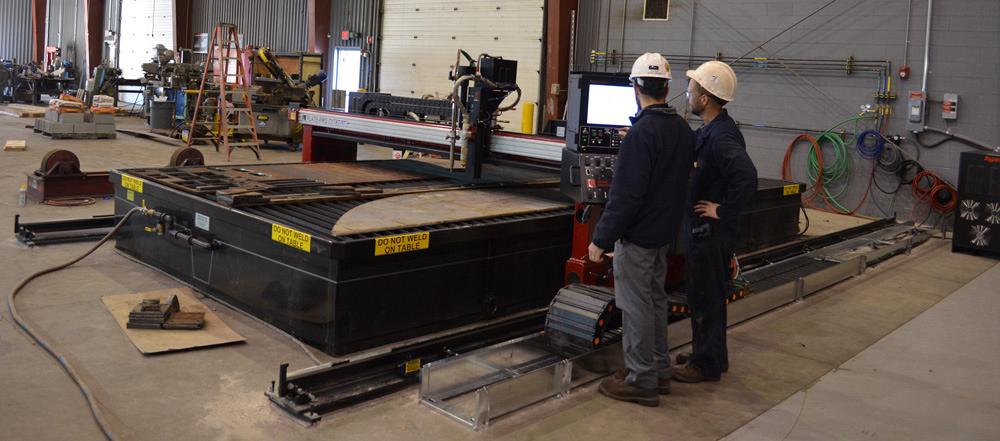Editor-in-Chief
- FMA
- The Fabricator
- FABTECH
- Canadian Metalworking
Categories
- Additive Manufacturing
- Aluminum Welding
- Arc Welding
- Assembly and Joining
- Automation and Robotics
- Bending and Forming
- Consumables
- Cutting and Weld Prep
- Electric Vehicles
- En Español
- Finishing
- Hydroforming
- Laser Cutting
- Laser Welding
- Machining
- Manufacturing Software
- Materials Handling
- Metals/Materials
- Oxyfuel Cutting
- Plasma Cutting
- Power Tools
- Punching and Other Holemaking
- Roll Forming
- Safety
- Sawing
- Shearing
- Shop Management
- Testing and Measuring
- Tube and Pipe Fabrication
- Tube and Pipe Production
- Waterjet Cutting
Industry Directory
Webcasts
Podcasts
FAB 40
Advertise
Subscribe
Account Login
Search
Redefining shipbuilding and fabricating with new plasma cutting equipment
Marine manufacturer takes control of its fabricating future with a new cutting table
- By Dan Davis
- January 15, 2015
- Article
- Plasma Cutting

Figure 1
Fabricating a workboat represents just one type of manufacturing that takes place at Great Lakes Shipyard’s 7.26-acre campus on the Cuyahoga River’s Old River Channel off of Lake Erie in Cleveland. (Photos courtesy of Great Lakes Shipyard.)
Some might think that the job shop world has very little in common with a manufacturing sector like shipbuilding. They actually might be surprised that both manufacturing sectors have a lot in common.
Of course, job shops have to tackle a variety of jobs during a typical workday, with volumes ranging from a handful to several hundred. Shipbuilders don’t have the high-volume orders, but the traits of their larger projects are similar to those of most fabricators’ jobs—no matter the industry type of work.
That’s why the folks at Great Lakes Shipyard (GLS) in Cleveland like to think of themselves as not only a shipbuilder (see Figure 1), but also a job shop offering steel fabrication, modification, and repair services. GLS can construct tugs and workboats, but it also fabricates barges, break walls, and industrial products such as tanks and other large weldments. It hasn’t been afraid of new challenges and complex jobs and is always looking for ways to expand its range of products and services.
GLS can do big. The company has a large 7-acre complex on Lake Erie and 5,800 lineal feet of dockage. It also has a 770-ton mobile lift used primarily to move vessels to and from the water. For its land-based fabricating activity, however, the mobile lift is an excellent machine for handling large, oversized pieces.
The company also has other unique weight-handling machines and equipment, including four 250-ton rail dollies. Its 10,900-sq.-ft., climate-controlled fabrication shop includes a 10-ton overhead crane that is used for most of the day-to-day fabrication operations.
Needless to say, GLS fabricators also work with a lot of plate. A recent job to fabricate a 92-ft.-long tug called for 530,000 lbs. of 0.5- and 0.375-in. steel plate for the hull and superstructure.
GLS can operate in tight time frames. Ship repair work on large lake bulkers is conducted between Jan. 1 and April 1, which is a tight window to conduct an extensive amount of maintenance and repair work. To complete the jobs in a timely manner to support the vessel operating schedules, GLS must work efficiently and around the clock.
GLS offers a variety of services well beyond general fabrication. The company not only employs welders skilled in gas metal arc, gas tungsten arc, and shielded metal arc welding processes, but also machinists, mechanics, and electricians (see Figure 2). It is a one-stop shop for all types of customers.
Boosting Thermal Cutting Capabilities
Despite the growth in its fabricating business, the management team knew that an in-house thermal cutting table could make manufacturing much more efficient. Until its purchase of a new Koike Aronson Plate Pro Extreme 3100 plasma cutting table (see Figure 3), GLS’s single most common delay was the amount of time required by the plate processing facilities.
The company could handle plasma cutting of straight-line cuts and simple geometries with its hand-held torches and track burners, but it didn’t have the means to handle plasma cutting of complex geometries, such as anything with a curved shape.
“You end up running into a lot of those on ships,” said Mike Satanek, GLS senior project engineer.
Once the table was up and running, all the benefits of having in-house CNC plasma cutting capabilities soon emerged.

Figure 2
Fabricating a new lake-worthy vessel takes a whole crew of skilled steelworkers, often numbering more than 100 over the several months needed to complete the job.
For example, GLS eliminated potential delays related to the cutting of complex shapes. Satanek said fitters now come off a ship with a cardboard cutout and present it to him so that he can program the cut on the plasma table. The cutting pattern can be drawn quickly in the machine’s programming software (see Figure 4) and burned on the table in a matter of minutes. The fitter saves the time that previously was required to cut using manual burning tools, which often led to several rounds of trial and error.
“Where these guys were spending hours trying to cut things by hand, they now bring it to us in minutes. We’ll draw it and burn it on the table,” said Jonathan Leivo, a GLS project engineer.
“So we keep them occupied with fitting and welding on the vessel, while we design and cut the more complicated parts.”
Just how complex can some of the cut parts be? GLS often has to cut its own custom wrenches to remove large tail shaft nuts, so that propellers can be easily removed for maintenance.
“Basically, we are fabricating our own 3-foot-long box-end wrenches for large propeller nuts,” Leivo said. “Most are typically hex nuts. Some on our older tugs have multi-slotted keys. These are round nuts with six slots on the outside diameter. The time to make this unique shape, something that a massive spanner wrench might be able to fit, is dramatically reduced with our own plate burning table.
“So we end up burning these custom wrenches ourselves from plate and do the job.”
Keeping It All Organized
GLS relies on consistent real-time communication to keep production moving along and projects on schedule. Project managers and production foremen meet daily to review progress and work instructions, and those orders are passed along to team leaders and work groups.
However, even when instructions are clearly prepared and experienced fabricators are on the job, assembly can still be a challenge. Oftentimes different parts simply look the same.
“Even with a copy of the drawing with all the shapes on it, there can be very slight differences,” Leivo said. “Sometimes you don’t realize that they aren’t the right fit until you try to fit them in place.”
To combat this, GLS uses the plasma cutting table’s etching capability. Parts are cut ahead of time for one day’s or two days’ worth of production, and the fabricators can tackle the job confidently because the etchings provide part numbers and any details, which ensures correct assembly.

Figure 3
The new Plate Pro Extreme 3100 plasma cutting table allows Great Lakes Shipyard to plasma-cut plate up to 1.50 in. on its 10- by 20-foot table. For anything thicker, it can turn to an integrated oxyfuel torch. For plate under 0.75 in., the fabricating shop can use the machine’s high-definition cutting feature to produce a smoother edge on the plate.
The Table Is Set
Satanek said GLS has cut stainless steel on the plasma cutting table with satisfactory results, but has yet to work with any aluminum. That will come in the future, as the company continues to look for new ways to put the equipment to further use.
It regularly quotes non-shipbuilding jobs (see Figure 5). Some may be marine-related, but others might be strictly linked to the land, such as LNG tank support structures.
“Whenever we find a project that can utilize our equipment and specialized skills, we don’t shy away from it,” Satanek said. “That’s what makes the job shop business so interesting.”
That’s spoken like a true fabricator.
About the Author

Dan Davis
2135 Point Blvd.
Elgin, IL 60123
815-227-8281
Dan Davis is editor-in-chief of The Fabricator, the industry's most widely circulated metal fabricating magazine, and its sister publications, The Tube & Pipe Journal and The Welder. He has been with the publications since April 2002.
Related Companies
subscribe now

The Fabricator is North America's leading magazine for the metal forming and fabricating industry. The magazine delivers the news, technical articles, and case histories that enable fabricators to do their jobs more efficiently. The Fabricator has served the industry since 1970.
start your free subscription- Stay connected from anywhere

Easily access valuable industry resources now with full access to the digital edition of The Fabricator.

Easily access valuable industry resources now with full access to the digital edition of The Welder.

Easily access valuable industry resources now with full access to the digital edition of The Tube and Pipe Journal.
- Podcasting
- Podcast:
- The Fabricator Podcast
- Published:
- 04/16/2024
- Running Time:
- 63:29
In this episode of The Fabricator Podcast, Caleb Chamberlain, co-founder and CEO of OSH Cut, discusses his company’s...
- Trending Articles
AI, machine learning, and the future of metal fabrication

Employee ownership: The best way to ensure engagement

Dynamic Metal blossoms with each passing year

Steel industry reacts to Nucor’s new weekly published HRC price

Metal fabrication management: A guide for new supervisors

- Industry Events
16th Annual Safety Conference
- April 30 - May 1, 2024
- Elgin,
Pipe and Tube Conference
- May 21 - 22, 2024
- Omaha, NE
World-Class Roll Forming Workshop
- June 5 - 6, 2024
- Louisville, KY
Advanced Laser Application Workshop
- June 25 - 27, 2024
- Novi, MI



























